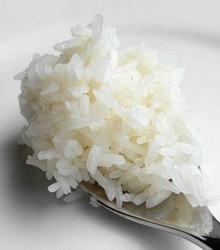 entists are closing in on genes in rice that regulate the uptake and storage of important minerals, a pursuit that could bolster the nutritional value of a grain that is a food staple for nearly half the world's population. The goal is to conventionally breed new rice varieties whose grains boast exceptionally high concentrations of one or more of 14 essential minerals, including zinc, iron and calcium, according to new research published in the Agricultural Research magazine.
entists are closing in on genes in rice that regulate the uptake and storage of important minerals, a pursuit that could bolster the nutritional value of a grain that is a food staple for nearly half the world's population. The goal is to conventionally breed new rice varieties whose grains boast exceptionally high concentrations of one or more of 14 essential minerals, including zinc, iron and calcium, according to new research published in the Agricultural Research magazine.Rice is a popular mainstay because it's a rich source of energy, free of gluten, easy to digest, low in fat and packed with vitamins, minerals and other nutrients; however, some key elements like iron are lost when the bran on unmilled brown rice is stripped off to produce white rice, said Shannon Pinson, a USDA's Agricultural Research Service (ARS) plant geneticist at the ARS Dale Bumpers National Rice Research Center in Stuttgart, Ark.
In developing countries, re-fortifying rice after milling may not be a viable option. In fact, the soils in which the crop is grown may be lacking in certain essential minerals, or the minerals are unavailable for uptake by the plant's roots.
To address these issues, the ARS-university team focused attention on three different population groups of rice—with the most diversity represented by 1,643 accessions collected from 114 countries. In this diverse group, they encountered rice accessions whose grains contained up to nine times the amount of minerals normally observed in standard U.S. varieties.
The team also is developing molecular marker data for use in rapidly identifying high-mineral rice plants without growing them to maturity during breeding operations. The team has so far identified 127 gene locations in 40 different chromosome regions that correlate to high concentrations of certain minerals and other grain features.





